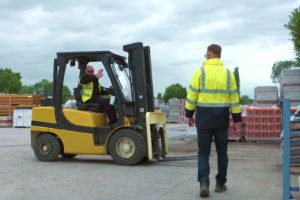Statistics highlight need for greater safety awareness among managers and forklift operators.
 Mentor FLT Training has released a new report on ways to improve site safety after its recent survey revealed the troubling realities of forklift operations.
Mentor FLT Training has released a new report on ways to improve site safety after its recent survey revealed the troubling realities of forklift operations.
Forklift Safety Insights was released to coincide with the Fork Lift Truck Association’s National Forklift Safety Month, an annual campaign that raises awareness in order to reduce the severity and frequency of lift truck accidents in the UK, which has taken place throughout October.
Survey respondents were taken from a sample of UK businesses operating forklift trucks on site. As well as forklift use, the survey investigated key areas, such as manager and operator training, safe systems of work, segregation, monitoring, and operating environments.
Alarming findings
Among the shocking statistics, the survey found that almost half of those overseeing forklift truck operations have not had any formal training on how to do so. A significant proportion of whom have no prior experience as an operator either.
While managers aren’t required to be certified operators, the absence of any relevant training in the risks surrounding forklift use is particularly worrying. Especially given their responsibility for the welfare of a company’s most valuable asset — its workforce.
In addition, one third of survey respondents admitted their operators had not received all three stages of training required by ACOP L117. Not only is this dangerous to the operator, who has received insufficient training, but it also puts colleagues who work around them at risk. And, if an accident were to occur, the business would be liable.
As well as insufficient training in the industry, the survey also revealed major room for improvement regarding site segregation. One in three survey respondents said that on their site, forklifts and pedestrians operated in the same area with no segregation between them, hugely increasing the risk of accidents and serious injuries.
Simple solutions
Mentor’s report tackles key problem areas highlighted by the survey, offering clear, effective solutions to help businesses reduce risk and ensure safe, productive and profitable sites.
“There are often simple, cost-effective measures that businesses can take which massively reduce the risk of accidents on site,” said Stuart Taylor, Managing Director of Mentor FLT Training. “The survey definitely highlighted some areas for concern, but the report is designed to help managers and operators understand the pitfalls and avoid the same mistakes.”
Mentor’s Forklift Safety Insights report is available to download now.
This eBook will guide you through some of the key understandings you need to be able to manage driver safety effectively and, at the end, provide a series of free resources you can access to help you ensure your own driver safety management system is robust, legally compliant and in line with industry-accepted good practice.
Download this eBook from Driving for Better Business and SHP to cover:
- Why do we need to manage driver safety?
- Duty of care – a shared responsibility;
- Setting the rules with a driving for work policy;
- Managing driver safety;
- Ensuring safe vehicles;
- Safe journeys and fitness to drive;
- Record keeping;
- Reporting;
- The business benefits of good practice;
- Additional resources

 Mentor FLT Training has released a new report on ways to improve site safety after its recent survey revealed the troubling realities of forklift operations.
Mentor FLT Training has released a new report on ways to improve site safety after its recent survey revealed the troubling realities of forklift operations.
People are generally still very complacent around forklifts. With that said, it’s hard to find someone who works alongside forklifts that doesn’t know of a significant accident that involved a colleague or someone they know. Lack of awareness and training is definitely part of it, though pedestrian segregation and transport management needs to be given higher priority as a means of managing risk.